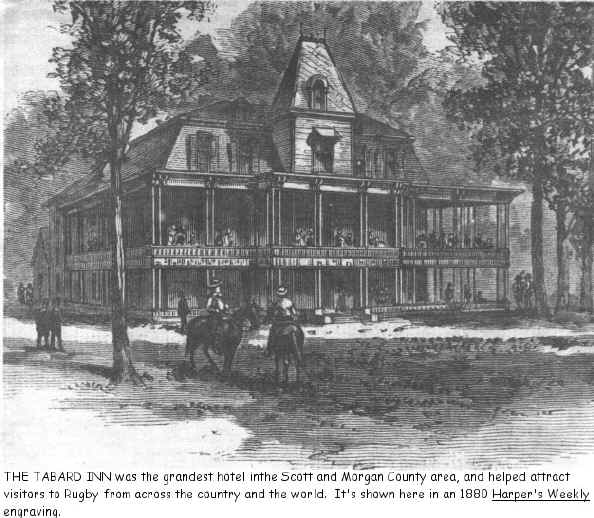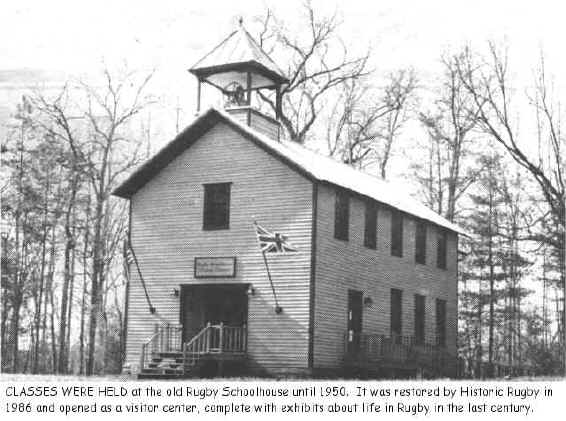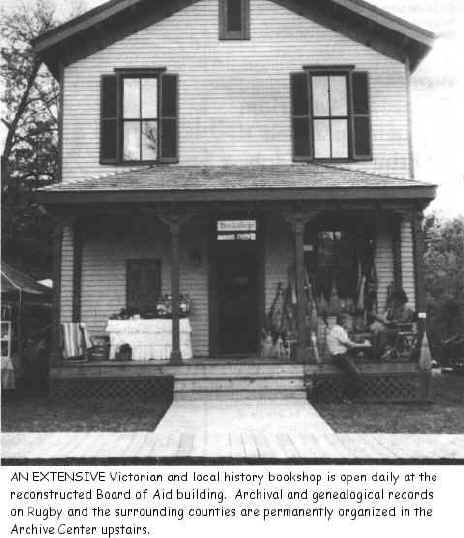FNB Chronicles
(page 1)
BARBARA STAGG
Contributing Columnist
Nestled among tall pines and oaks just west of the Scott County line in Morgan County lies Historic Rugby, a British-founded village whose Utopian dream of a better life in America has never quite died.
Idealistic author and social reformer THOMAS HUGHES expressed his hopes for this new colony on October 5, 1880, on its official opening day: "Fore we are about to open a new town here.., a new centre of human life, human thought, human activities.., in this strangely beautiful solitude; a center in which a healthy, hopeful, reverent life shall grow."

HUGHES, famous as the author of the classic Tom Brown’s Schooldays, envisioned his new community as a place where Britishers and anyone else who wished to come would build a strong agricultural community through cooperative enterprise, while maintaining a cultured, Christian lifestyle. He also intended the colony to be "free of intoxicating beverages" and of the rigid class distinctions that prevailed in Britain. (Some of the young men in early Rugby simply walked or rode from Rugby over today’s Nydeck Road to the wide-open coal and coke-mining town of Glenmary to partake at its saloons.)
That Rugby was started in this part of East Tennessee relates directly to the establishment of the Cincinnati-Southern railroad in 1878, which for the first time, opened Scott and surrounding counties to increased settlement and marketing potential. The first railroad station to bring incoming Rugby settlers was at today’s Robbins; by 1881 a station was established a Sedgemoor, later called Rugby Road and today known as Elgin.
The Rugby community both flourished and floundered during the 1880s, attracting wide-spread attention on two continents and hundreds of hopeful settlers from both Britain and other parts of America. The idea for the colony grew out of HUGHES’ concern for the younger sons of landed British families. The custom of primogeniture usually meant that only the eldest son inherited the family estate, leaving younger sons with little future other than a few socially acceptable occupations such as the priesthood or the military. In America, HUGHES believed, these young men’s energies and talents could be directed toward community building through agriculture.
During its peak in the mid-1880s, HUGHES vision seemed bent on becoming a thriving reality. Some 70 graceful Victorian building, had been constructed on the beautiful townsite, located between the Clear Fork River and White Oak River, and over 400 residents enjoyed the rustic yet culturally refined atmosphere of this "New Jerusalem." Literary societies and drama clubs were established. Lawn tennis and cricket
(Continued on page 4)
(Continued from page 1)
grounds were laid out and soon in use. The grand Tabard Inn, named for Chaucer’s Canterbury Tales, soon became the social center of the colony and a destination for visitors from all over the world. The Thomas Hughes Public Library, with thousands of volumes donated by admirers and publishers, was the pride of the colony. The press of both America and Europe carried updates on the colony’s progress and problems. Rugby printed its own weekly newspaper, and general stores, stables, sawmills, boardinghouses, a drug store, dairy and butcher shop were all in operation.
But underneath the seemingly idyllic atmosphere was an insecure foundation. A typhoid epidemic, which claimed seven lives in 1881, did nothing for the colony’s Utopian image or its credit rating. In addition, financial troubles, land title problems and cruel Cumberland Mountain winters gradually brought about Rugby’s decline. An added problem was the failure of the Cincinnati-Southern Railroad to build a spur line through Rugby, as they originally had promised. By the 1890s many of the original colonists had left for other parts of America, unable to prosper in Rugby.
THOMAS HUGHES, whose aged mother, his brother HASTINGS and niece EMILY, lived in Rugby during its early years, managed to spend only a month or so each year in the colony. He poured nearly $100,000 of his own money into the effort to comunity-build in the wilderness. In spite of Rugby’s obvious problems and failures, HUGHES never gave up hope for the colony’s future. In a letter to some of the remaining settlers shortly before his death in 1896, Hughes wrote poignantly: "I can’t help feeling and believing that good seed was sown when Rugby was founded and someday the reapers, whoever they may be, will come along with joy bringing heavy sheaves with them."

During its early decades, the founding of Rugby had a direct impact on the establishment of other communities, in addition to Elgin, on this part of the Cumberland Plateau. German businessmen from the north were attracted to Rugby in the early 1880s with thoughts of settling there. Then-Rugby land manager CYRUS CLARK, who personally owned land west of the Rugby colony, ended up selling them what is today the thriving town of Allardt. Well-known northern hotel man ABNER ROSS came to Rugby in 1881 to revive the Tabard Inn hotel after the typhoid epidemic. By 1884 the hotel and Rugby were beginning to thrive as a tourist destination as well as a viable town. But the Tabard burned in 1884, beginning the colony’s decline. ROSS, still believing in the agricultural and tourism potential of the area, bought land about 12 miles south of Rugby at a spot known as Dead Level. He had streets and lots laid out, built a home for his family, a large hotel and an enclosure for the pet deer he had kept for the young guests at the Tabard. This new town became known as Deer Lodge and is still a sizable community today.
While Rugby definitely dwindled, it was never deserted. Individual residents over the decades struggled to keep its fascinating heritage alive and its surviving buildings and lands protected. Notable among these folks were WILL and SARAH WALTON, NELLY LENDER BROOKS, NONA and LOLA SMITH, HELEN TURNER, PATRICIA WICHMAN, HELEN LOURIE, OSCAR MARTIN, JIMMY KEEN and others. Many families with ties to both Scott and Fentress counties lived in Rugby over the decades up to today.

In 1966 non-profit Historic Rugby was formed by area residents to begin the work of restoring and preserving the village. In 1972 the entire village was listed on the National Register of Historic Places. Today some 70 residents live in Rugby, where 20 of the original Victorian buildings still stand in rugged river gorge surroundings. More than 60,000 visitors from all 50 states and 25 foreign countries found their way to Rugby in 1991.
Visitors can enjoy a leisurely tour of restored historic buildings — the Schoolhouse Visitor Centre where exhibits trace a century of Rugby history; Christ Church Episcopal with its hanging lamps and 1849 rosewood reed organ still in use; the Thomas Hughes Library, its 7,000-volume collection and furnishings unchanged since the doors opened in 1882; and the founder’s home, Kingstone Lisle, now restored and furnished with early Rugby pieces. Tour facilities are open daily from February 1 through December 31.
Historic Rugby has also restored or reconstructed original buildings to provide additional visitor facilities. Unique overnight lodging is available year-round at restored Newbury House B&B and Pioneer Cottage, both built in 1880. Newbury has five beautifully furnished Victorian bedrooms and a guest’s parlor. Pioneer is a housekeeping cottage with three bedrooms, parlor and furnished kitchen. Two other Victorian cottages are also available for guests through Historic Rugby. Private owners in the Rugby community have also established a small motor lodge and another bed
(Continued on page 5)
(Continued from page 4)
and breakfast facility.
The historically reconstructed Rugby Commissary features locally-made traditional handcrafts, British Isles products, old-time Watkins extracts and spices and much more, and is furnished with old general store antiques. More than 100 area craftspeople now consign or sell their work at the Commissary. Next door, the recently reconstructed Board of Aid building holds an extensive Victorian and local history bookshop downstairs and an archive and research centre. upstairs. The archive contains hundreds of historic documents, manuscripts, letters, newspapers, memoirs, deed records and historic photographs, not only of Rugby, but also of surrounding communities, including Huntsville, Elgin, Robbins, Allardt, Burrville, Deer Lodge, Sunbright, etc. If readers have any materials such as pictures, letters, furnishings, etc., that relate to early . Rugby, please call the Historic Rugby office at 628-2441 so that they can be copied or photographed and added to the permanent archive for future generations.
The recently built Harrow Road Cafe, which is open every day, blends with Rugby’s historic architecture and seats up to 80 in two wood-beamed dining rooms. The menu features Cumberland Plateau home cooking and British Isle specialties.
Historic Rugby also hosts several special events each year which attract thousands of people. The 1992 schedule includes: Spring Music & Crafts Festival, May 16 & 17; Pilgrimage of Homes, October 3 & 4; and Christmas at Rugby, December 5 & 1Z. Historic Rugby also sponsors an annual Tri-County Day, set for November 7 this year, when all residents of Scott, Morgan and Fentress counties are invited to tour the historic buildings and other public facilities with no admission charge.
Non-profit Historic Rugby is a state-chartered membership organization with a 15-member board of directors, elected by the members. Membership Benefits include free site admission year-round, free admission to the Spring Festival and Fall Pilgrimage, discount on bookshop purchases and newsletters and other mailings. While Historic Rugby has more than 1,000 members today, many more are needed to help support the 12 public buildings, educational programs and workshops and the exciting potential for further restoration and reconstruction of visitor and community facilities. An individual membership is $15; family memberships are $25.
That Historic Rugby is not a typical historic site is evidenced by a current project to develop 27 wooded, residential building lots on the original townsite, ranging in size from seven-tenths of an acre up to two and a half acres. This area, known as Beacon Hill, was laid out in the 1880s for homes, but few were built. Protective restrictions on the property require the building of architecturally compatible homes. Anyone who would like, more information and would like to be notified when the lots are placed on the market should call the Historic Rugby office at 628-2441.
Literally hundreds of miles of some of Tennessee’s finest hiking trails surround Rugby in the Big South Fork National River & Recreation Area, Pickett State Park, Frozen Head State Park, and the recently protected Colditz Cove Natural Area. Rafting, canoeing, fishing, camping, swimming, mountain biking and equestrian trails are all available to the outdoor lover, and more and more visitors are discovering this beautiful corner of the- Cumberland Plateau.
In addition to its commitment to continue restoring and preserving this unique historic site for this and future generations, Historic Rugby strongly believes in the economic benefits that tourism can bring to the area, and the need for all scenic resources, attractions, towns and counties to work together to attract visitors and serve them well when they come.
For more information, call or write Historic Rugby, P.O. Box 8, Rugby, TN. 37733, 615-628-2441 [The correct phone number, as of 3 Sep 2000, is 423-628-2441, due to area code changes. You can also visit their website at www.historicrugby.org]
FNB Chronicle, Vol. 3, No. 4 – Summer 1992
First National Bank
P.O. Box 4699
Oneida, TN 37841
(p1, 4-5)
![]() This
page was created by Timothy
N. West and is copyrighted by
him. All rights reserved.
This
page was created by Timothy
N. West and is copyrighted by
him. All rights reserved.